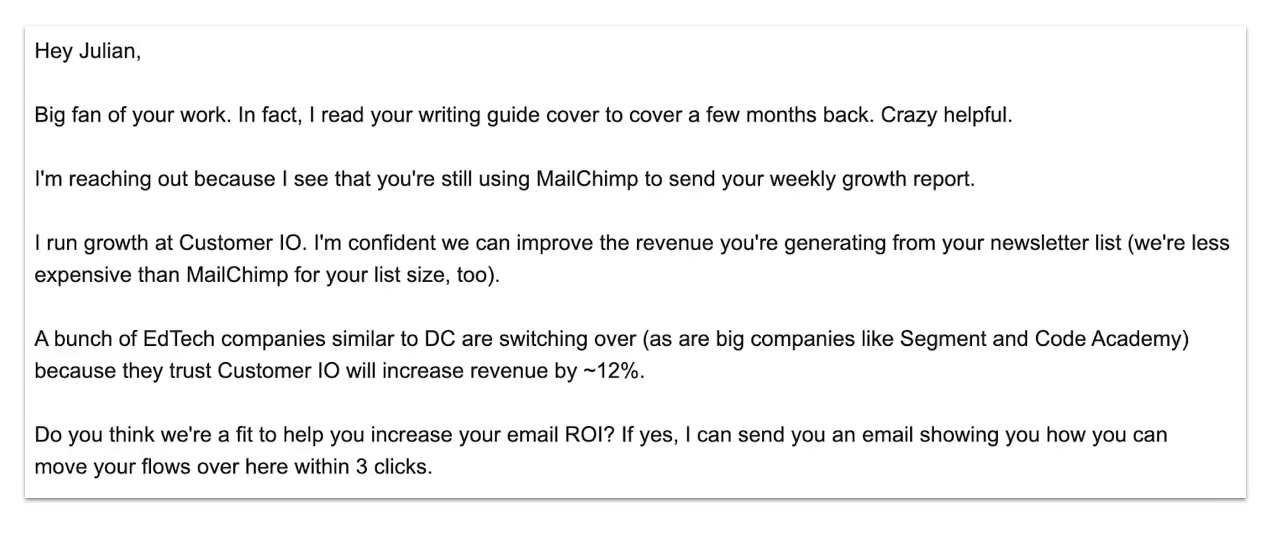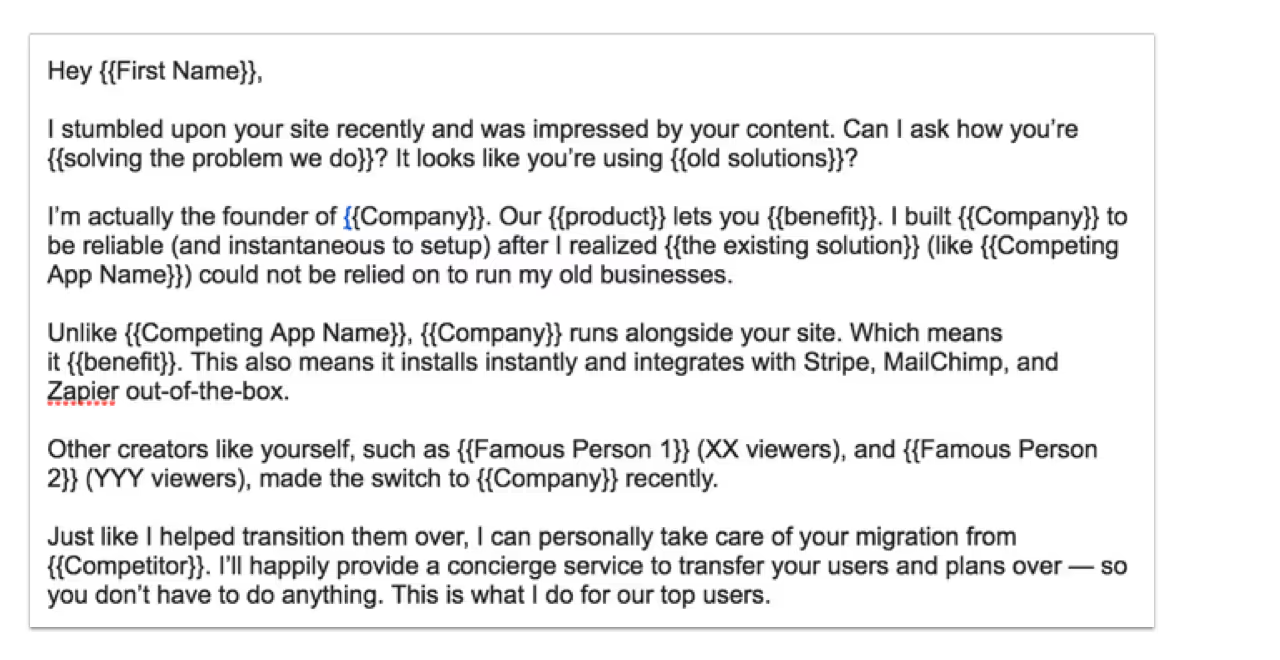
Conversation

🥳 Feedback Received!
Thanks for taking a moment to share your thoughts — it genuinely helps us make each chapter sharper.
What happens next:
- Your feedback goes straight to our product team.
- We’ll use it to refine lessons, clarify examples, and make the program even more useful.
Appreciate you helping make this program better for everyone.
Ready for your next challenge? 👇
Introduction: Cold Outreach
Here’s what we’ll cover in this module:
- Determining which people are worth targeting
- Finding their contact details
- Writing great cold emails
- Relevant case studies to help you test cold email for your startup
- Building a process for sending emails
- Optimizing performance
- Other tactics (like pre-targeting, Twitter, and LinkedIn)
Overview
“Cold outreach” refers to reaching out to someone who doesn’t know you in order to build a relationship and eventually transact with them (a sale, favor, or an opportunity).
Examples:
- B2B SaaS startups reach out to Enterprise businesses to sell their products.
- Agencies reach out to business owners to sell their services.
- B2C companies reach out to high-profile influencers for affiliate partnerships.
- Freelancers reach out to business owners to get contract work.
Cold outreach is the lifeblood for some early stage startups. When you’re strapped for cash, you can put your time into cold outreach and secure sales that give you the cash flow to get off the ground.
In this module, we’ll focus on cold outreach for the purpose of lead generation—creating a flow of leads. “Leads” are simply prospects that we’ll turn into paying customers through further email, calls, or demos.
There are a number of ways you can use cold outreach to connect with prospects, including:
- Email: Agencies can send targeted emails that help business owners solve pressing problems.
- LinkedIn: B2B SaaS companies can close demos by sending direct messages to people with specific job titles.
- Twitter: Founders can use tools to find VCs in their networks and pitch their portfolio companies.
- Physical mail: An insurance broker sends a letter to every new homeowner as they move to the neighborhood.
- Cold calling: Isn’t a fit for most modern startups anymore. Not many decision makers 1) answer calls from random numbers nor 2) have the patience to sit through a sales call. Calls work—but they’re used to close leads that you warmed up through other forms of cold outreach.
Cold email generally outperforms all other cold outreach channels. So we’ll focus primarily on that. But we’ll also cover novel cold outreach methods that are working for fast-growing startups, including Twitter and LinkedIn outreach.
Move on from cold calling
Cold email is a modern day take on cold calling.
Companies used to grow leads by “smiling and dialing.” Now, technology has improved to the point where companies can nurture leads through email before moving leads down funnel with:
- More emails
- Scheduled calls
- Webinars
- Product demos
Cold email doesn't need to bear the burden of closing the deal. It’s sole purpose is to move people along the funnel.
Why you need to learn cold email
No one likes getting cold emails.
But when it’s done correctly, it works. Some businesses single-handedly grow through cold email.
Here’s an example:

This is cold email perfection:
- Clearly indicate why you’re reaching out and how you’ll add value—and be specific: “Customer IO will increase revenue by ~12%.”
- Proactively handle key objections.
- Add a personal touch up front, which acts as the hook for the rest of the note.
- End with one clear CTA. And since it’s the first email, ask for interest instead of time in your CTA. “Do you think we’re a fit?” works better than “Let’s book a call” at first.
- Includes “persona-matching”—the presumed sender of the email isn’t a salesperson. It’s the employee who most closely matches the role of the intended recipient. This builds trust and can lead to better cold email ROI.
We’ll teach you how to send effective cold email campaigns like these.
What makes email so great?
- Targeting: Emails let you target exactly the people you want, and when done right, they’re so personalized that people can’t help but respond. You can’t get that with ads. Why? Ads cast a wider net, meaning you’ll always end up hitting people who will never buy from you. A 2% CTR would be impressive with ads. For email? You can see CTRs as high as 50% on strong campaigns.
- Access: Most decision makers still manage their own email inboxes. This is a massive opportunity. So long as you have the correct email address, your message lands in front of decision makers as they’re actively making business decisions.
- Low capital investment: All you need is an email account, and potentially software to help you automate your process. So it makes sense to start with this channel if it has potential for you. That way you’re not burning cash before you’re generating revenue from clients.
Who should use cold outreach
Most early stage startups should test cold outreach, but it’s most profitable for B2B companies.
Why?
Cold outreach isn’t “free”—that’s a common misconception. Due to the labor involved in outreach and sales, CACs can be relatively high. In many cases, only high margin products can support cold outreach as a growth channel.
B2B companies typically have a higher margin than consumer companies.
Think of it like this:
Say you run an online shoe company where you sell $100 pairs of shoes that cost you $25 to make. Cold outreach might not be worth your time: You’ll likely spend hours sending emails, setting up calls, and managing the funnel. Labor hours would exceed your $75 margin.
But for a B2B SaaS business selling $1,000/month contracts? 5 labor hours to close a deal might result in thousands of dollars of profit.
That doesn’t mean you should rule out cold outreach if you’re not at a B2B company with high margins.
You can still make cold outreach work. Here’s a framework for identifying companies that cold outreach could work for:
- High margin products that can afford the labor of emailing and closing.
- Products that are expensive and people aren’t actively searching for them (if people are searching for your product, search ads and content might be more effective).
- Most early stage startups that need a low capital investment way to sell and generate revenue so that they can afford to test other channels—like running ads or hiring a content writer.
Specific examples of companies that should test cold outreach:
- Agencies who charge $2000+/month per client and collect their first payment after the first month.
- Most B2B SaaS companies.
- Companies selling expensive physical goods (like equipment or medical devices).
- Edtech companies that sell high-margin digital products.
If you’re deciding whether or not you should test cold outreach, here’s an actionable framework. Test cold outreach if you meet one or both of the following criteria:
- If your profit margins are greater than $500 per closed deal AND your payback period is less than 2 months, you should consider trying cold outreach.
- You’re at an early stage startup that sells products over $100 and you can afford to sell at low margins to get off the ground—do things that don’t scale until you can afford to test channels that scale.
Creating a cold email strategy
Here’s what a cold outreach pipeline could look like:
- Generate a prospect list.
- Invite the qualified prospects (via email) to an online product demo, sales call, or webinar.
- Address their objections and entice them to purchase.
- Negotiate and close their contract.
We’ll show you how to test cold outreach as a growth channel. That means standardizing your approach and running tests to see if you can acquire customers profitably through cold outreach.
Client story
Demand Curve worked with a company that sold a Wordpress plugin—one that lets you easily add an email newsletter subscription to your site.
All the competing plugins had issues: They were hard to integrate, poorly designed, and in general just a pain to work with.
How did cold outreach help them? We programmatically scraped blogs to find people who were using a competing plugin. Then, we used a virtual assistant to pull the name of the company behind the site and looked up the owner’s email address on Clearbit. We sent them a cold email referencing the exact competing plugin that they were using and why it was worse than ours.
Here’s a screenshot of that email:

That email led to over $500,000 in sales within a couple months. Over 40% of people responded to our emails. (Response rates are usually 2-10%).
This story is an extreme example—most targeting strategies won’t require coding like this—but it shows the power of personalized emails sent to a highly targeted audience. Spraying and praying won’t get you anywhere.
It’s important to note that this same strategy could work even if we didn’t get email addresses.
You could, for instance, find your targets’ associated LinkedIn and Twitter profiles. Then reach out on either platform. Cold outreach on social platforms works particularly well if you have a sizable following that acts as social proof: Large followings indicate that you provide lots of value. If you don’t have a following, email generally works better.


